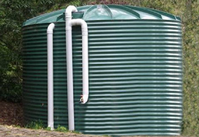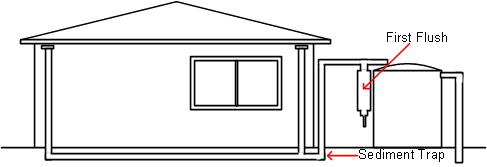First flush diverters have limitations
- many are high maintenance
First flush diverters are more effective harvesting tin rooves than when harvesting tile rooves. Tin rooves drain faster, their smooth surfaces are quickly washed and the generated heat can have a sterilising effect on bird droppings and other contaminants.
SHORTCOMINGS
The floats `job’ is to prevent captured flush being extracted by a venturi effect but solid contaminants will wash over the float once the chamber is `sealed’. chamber filters `job’ is to prevent the debris from blocking the dripper but the debris can also block the filter. Captured debris does not magically disappear and someone has to regularly empty the chamber and clean the filter.
THIS IS MESSY AND HIGH MAINTENANCE!
Ideally, the flush chamber will have an additional manual discharge port to enable full chambers to be emptied should the internal filter or dripper block. This allows cleaner access to clean the filter.
WARNING: A small capacity first flush system fitted to a vertical riser should be considered with extreme caution. Sediment transfer requires an adequate flushing velocity and without it, the system is at risk of becoming a stagnant sediment trap that will eventually block. First flush is best captured at the downpipe.
Tiled rooves are numerically the most popular but their rougher and often weathered surfaces and grooves makes natural roof washing a slower process.
Domestic first flush divert chambers are commonly 90mm or 100mm PVC pipes which hold 5.8 and 8.5 litres respectively for each one metre length. For reasons both practical and aesthetic, most domestic units are rarely more than 1.5 metres long; therefore 1.5 metre lengths of 90mm and 100mm PVC pipe hold about 8.7 litres and 12.8 litres respectively.
Recommended first flush capacities vary between .5mm to 2mm for each square metre of roofing harvested. Given that large amounts of solid pollutants are not immediately washed from rooves and gutters, the average domestic first flush diverter is expected to perform a minor miracle.
The initial first flush contains the most contaminated water and a first flush diverter is a recommended accessory but homeowners need to be aware of practical limitations and not expect miracles.
Most popular flush diverters have utilised a float that rises and seals a collection chamber after it fills, often an internal filter and a self emptying drip system fitted to the chamber's bottom outlet. This system in various guises has been around for a long time and variants are found in many countries. Other first flush diversion methods appear from time to time but the above method has found most favour for its apparent simplicity and low cost.
Domestic first flush divert chambers are commonly 90mm or 100mm PVC pipes which hold 5.8 and 8.5 litres respectively for each one metre length. For reasons both practical and aesthetic, most domestic units are rarely more than 1.5 metres long; therefore 1.5 metre lengths of 90mm and 100mm PVC pipe hold about 8.7 litres and 12.8 litres respectively.
Recommended first flush capacities vary between .5mm to 2mm for each square metre of roofing harvested. Given that large amounts of solid pollutants are not immediately washed from rooves and gutters, the average domestic first flush diverter is expected to perform a minor miracle.
The initial first flush contains the most contaminated water and a first flush diverter is a recommended accessory but homeowners need to be aware of practical limitations and not expect miracles.
Most popular flush diverters have utilised a float that rises and seals a collection chamber after it fills, often an internal filter and a self emptying drip system fitted to the chamber's bottom outlet. This system in various guises has been around for a long time and variants are found in many countries. Other first flush diversion methods appear from time to time but the above method has found most favour for its apparent simplicity and low cost.
SHORTCOMINGS
The floats `job’ is to prevent captured flush being extracted by a venturi effect but solid contaminants will wash over the float once the chamber is `sealed’. chamber filters `job’ is to prevent the debris from blocking the dripper but the debris can also block the filter. Captured debris does not magically disappear and someone has to regularly empty the chamber and clean the filter.
THIS IS MESSY AND HIGH MAINTENANCE!
Ideally, the flush chamber will have an additional manual discharge port to enable full chambers to be emptied should the internal filter or dripper block. This allows cleaner access to clean the filter.
WARNING: A small capacity first flush system fitted to a vertical riser should be considered with extreme caution. Sediment transfer requires an adequate flushing velocity and without it, the system is at risk of becoming a stagnant sediment trap that will eventually block. First flush is best captured at the downpipe.
The floats `job’ is to prevent captured flush being extracted by a venturi effect but solid contaminants will wash over the float once the chamber is `sealed’. chamber filters `job’ is to prevent the debris from blocking the dripper but the debris can also block the filter. Captured debris does not magically disappear and someone has to regularly empty the chamber and clean the filter.
THIS IS MESSY AND HIGH MAINTENANCE!
Ideally, the flush chamber will have an additional manual discharge port to enable full chambers to be emptied should the internal filter or dripper block. This allows cleaner access to clean the filter.
WARNING: A small capacity first flush system fitted to a vertical riser should be considered with extreme caution. Sediment transfer requires an adequate flushing velocity and without it, the system is at risk of becoming a stagnant sediment trap that will eventually block. First flush is best captured at the downpipe.


The Cooperative Research Centre (CRC) for Water Quality and Treatment research report 39 (Guidance Manual for the design and installation of urban roofwater harvesting systems in Australia) states that research has shown first flush results are variable at best and particulates have been detected throughout the entire rainfall event(s). This coincides with AQUATREK’S studies over a two year period.
The research report; RAINWATER FIRST FLUSH DEVICES – ARE THEY EFFECTIVE? Gardner, Baisden, Millar, (2004) quotes percentage reductions for bacterial loads, suspended solids and trace metal contaminants when using first flush diverters and is interesting reading.
Supadiverta - better than the rest!
Rainwater quality and the retardation of tank sediment build up improves substantially when solid bird droppings and other particulates are continuously diverted by the SUPADIVERTA’S internal 750 micron divert filter.
When the SUPADIVERTA FIRST FLUSH KIT is installed, the initial roof wash and small particles are also captured in the flush chamber. The SUPADIVERTA FIRST FLUSH KIT has no internal parts and sediment access to the flush chamber is not restricted during the rain event.






